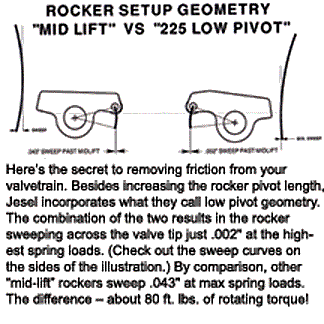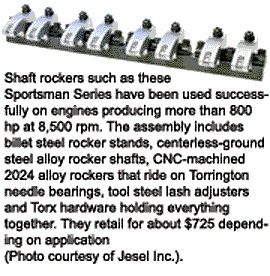When the Chevrolet small-block V8 was introduced in 1955, one of its most highly touted features was its lightweight, high-revving ball and stud stamped steel rocker design.
Around 1962, several of my buddies proved that claim to be true, time and again, when they twisted their Duntov-cammed 283s to 7,200 rpm. In fact, this same stud rocker setup served performance and racing enthusiasts for years before it became overstressed and the Band-Aids® started to appear.
The first modification was to install polylocks, to maintain valve lash longer and adjust the hydraulic lifters so that they didn’t pump up at high rpm. Those of you who go back a few years probably remember the progression. As more aggressive cam profiles and valve spring pressures increased, press-in studs started pulling out of their bosses. The easy fix was to drill the boss and stud and pin them with a roll pin.
Then Chevrolet came out with screw-in studs that didn’t pull out, but their small diameter allowed them to flex too much. The fix was larger screw-in studs made out of stronger alloys. As spring pressures continued to escalate, they too would flex, so stud girdles were invented to tie all of the studs together, mimicking the solid shaft-type rockers found on Chevy’s sister division engines like Cadillac and Buick.

History of Aftermarket Shaft Rockers
Dan Jesel, the founder of Jesel Valvetrain Innovation, is credited with inventing the first effective aftermarket shaft rocker system. It’s an interesting story on how he discovered the real need for shaft rockers.
He was building drag racing engines for several customers, and he had two engines: a small-block and big-block Chevy on engine stands ready to be delivered. As was standard procedure, Dan would rotate the engines with a torque wrench to make sure everything was okay (nothing tight or binding). He would check rotating torque at several stages of the build-up.
Both engines checked out fine, until the final torque reading was taken with the valvetrain installed and lashed. The small-block took approximately 80 ft.lbs. more torque to rotate than the big-block. That didn’t make any sense, because the small-block was less than 302 cid and the big-block was more than 427 cid. Common sense would tell you that the big-block would have more piston ring drag, and should require more force to rotate.
After taking the small-block apart several times to see if something was amiss, Dan thought about this problem on his several-hour tow to the race track. Then he had the “Eureka” moment. The only thing different (other than displacement) between the two engines was the rocker arm pivot length.
That’s right, the small-block had a rocker pivot length of about 1.40″. The big-block on the other hand had a pivot length of 1.65″. What that means is that the big-block rocker tip travels in a much larger arc, which results in minimized “scrubbing” motion across the valve tip. The small-block rocker with the shorter pivot length sweeps across the valve tip, causing increased friction and binding.
In production engines with low lift cams and valve spring pressures, the friction is greatly reduced, but when you start putting big loads on the valvetrain from higher lift and higher spring loads, the friction goes up exponentially.
To prove his theory, Dan took a set of small-block cylinder heads and relocated the rocker studs away from the valves, so he could use big-block rockers. The rotating torque test confirmed what he expected – it took 80 ft.lbs. less torque to rotate the small-block with big-block rockers.
Soon thereafter he was moving studs on all of his customer’s small-block engines, when he decided there must be an easier way. There was. He designed a shaft rocker system with stands that bolt to the standard stud bosses, yet relocated the rocker pivot point any distance he desired away from the valves.
That’s the crux of the entire stud vs. shaft debate – you can’t change the rocker pivot length and correct the rocker geometry unless you move the pivot point. So, no stud rocker can perform as well and as reliably as a longer pivot shaft rocker – it’s that simple.

Shaft Rocker Benefits
Many engine builders are still struggling today with stud rockers, girdles and polylocks – antiquated parts that have no place in a modern performance engine. So if you want to add value to the performance engines you sell to your customers, it’s time to make a switch to shaft rockers that add little or no extra cost to the engine build, but have huge benefits for your customers, and increased profits for you. Here’s why:
More Power – Reduced valvetrain friction equals more power, regardless of valve lift or rocker ratio. Shaft rockers are more stable at high rpm ensuring accurate valve timing events. Shaft rockers are mounted to the head using a steel stand that positions the roller directly over the valve tip, while the stud rocker is aligned by the stud location and a .080″-wall tubular pushrod and guideplate – which one would you rather have in your engine?
In many cases the valve, stud and pushrod guide are not actually in line, as found with most small block Chevy intake rockers. This misalignment was generally compensated for in the stamped pivot ball rockers, but became a serious liability to the stud mounted roller rocker as it had no way to correct the misalignment with their single plane trunions.
Increased Reliability – Because the longer pivot length rocker does not side-load the valve as much, shaft rockers are easier on valve guides, valve seats and valve tips – fewer comebacks for the engine builder.
Shaft rockers simply rotate to take up valve lash – stud rockers slide up and down the stud taking up the valve lash before they open the valve. Example: If your valves are lashed at .030″, your stud rockers are sliding up and down the stud every time the valve opens. Just imagine this slide-hammer effect at 7,000 rpm! And when valve float occurs, the entire weight of the rocker is loaded onto the valve tip until the system resets.
User Friendly – Lashing the valves with stud rockers and the attending stud girdle is a pain in the neck. First, you loosen the stud girdle, lash the valves, and then re-tighten the stud girdle. If the studs are the least bit out of alignment, tightening the stud girdle changes the valve lash.
Shaft rockers hold lash much longer and are easier to lash properly. On some vehicles like 5.0L Mustang racecars, the valve covers are very difficult to remove between rounds, so having a vehicle that can go the entire race weekend without adjusting the valves is a big deal.
Many racers have found they can remove shaft rockers from their stand to change a valve spring and return them without adjusting the lash again.
More Options – Shaft rockers also offer other desirable features: they are more adaptable to constantly changing cylinder heads, they enable pushrod offsets to clear wider ports, and have assorted pivot lengths to accommodate a wide range of ratios, 1.4 through 2.25!
The Bottom Line
So what’s this upgrade to shaft rockers really going to cost an engine builder? If you price out a set of aluminum roller rockers, quality studs and guideplates, and a stud girdle, the cost is very similar to the value-priced shaft rocker systems sold by Jesel, T&D and several others.
The retail price is approximately $750 for a complete shaft rocker system and very often various higher ratios are available as well. This is certainly a worthwhile upgrade for a customer’s engine that you can mark up with a higher margin, especially once the customer understands the benefits it will provide.
Many consumers are under the impression that a high-quality shaft rocker system is a $2,500-$3,000 investment, so it should be a fairly easy up-sell.
High-performance engine buyers understand that when it comes to hardware, you get what you pay for. With a well-designed shaft rocker system, they get more performance, reliability, and peace-of-mind.













